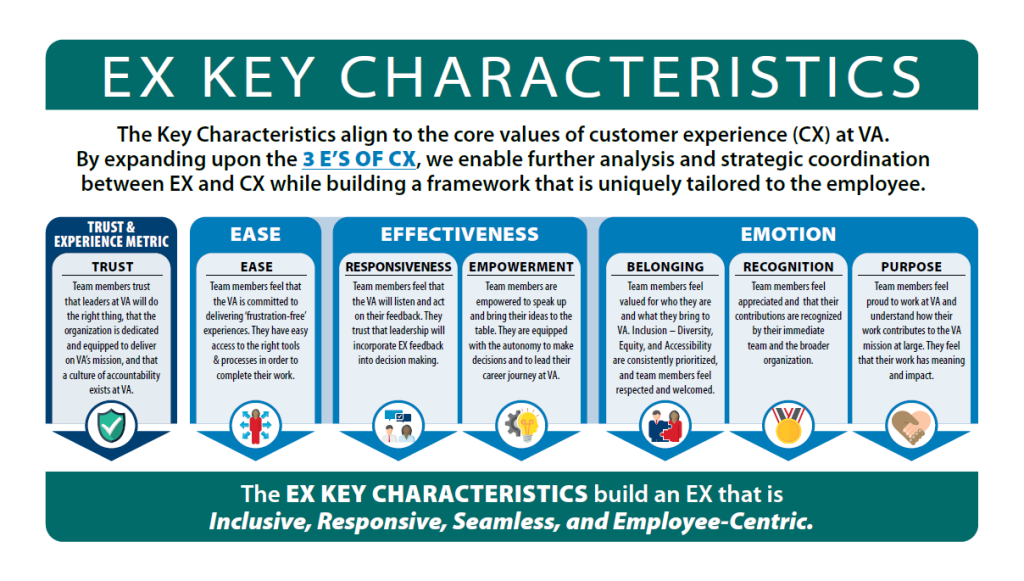A Conversation with Airis Gill, U.S. Department of Veterans Affairs Executive Director of Employee Experience and Organizational Management

In December 2021, President Biden issued an Executive Order on Transforming Federal Customer Experience and Service Delivery to Rebuild Trust in Government. The prioritization of customer experience initiatives had me and my colleagues eager to get in, roll up our sleeves, and take on big projects to improve service delivery to the public.
Intuitively, this made sense to me.
But a strange thing happened last year. Instead of seeing procurements for citizen-facing projects, Federal agency forecasts were filled with something else: Procurements for support with employee experience.
You can’t serve your customers effectively if your own house isn’t in order. And happier, more purpose-driven Federal employees are going to go the extra mile to resolve, say, a housing voucher payment problem or support a Veteran through a benefit conundrum. But was there a way to connect the two initiatives?
Impressed by the work at the Department of Veterans Administration (VA), I turned to Airis McCottry Gill, the Executive Director of Employee Experience and Organizational Management, to learn more about VA’s efforts to measure and improve both VA employee experiences and the customer experience for veterans, their families, caregivers, and survivors.
Gill shared some background: The Veterans Experience Office (VEO) debuted in 2015 with a focus on understanding the needs of the veterans community. The VEO set out to understand the veterans community experience from their perspective, not from what the VA thought they wanted or needed.
This represented a fundamental shift in how the VA had approached tools and services in the past. The VEO used a series of projects, journey maps, and user research to understand the customer experience (CX). VA then realized the same methods and techniques could help to better understand the employee experience (EX). As they have embarked on the EX journey, the next step is to see what impacts or correlations there are between EX and CX.
Each year, the VA surveys all employees in a format similar to the Federal Employees Viewpoint Survey (FEVS), a bit like an annual wellness check through the All Employee Survey (AES). In addition to yearly survey findings, VA wanted more real-time feedback, a sort of trail of breadcrumbs on how things were going. Added Gill, “Adding the ability to layer quarterly feedback with the current annual survey gives more power to the Voice of the employee and VA’s ability to react to it.”
As a big fan of data-driven decision-making, VA recently launched the first Employee Experience Trust and Experience Survey. Following the blueprint from CX, this quarterly survey of sampled employees measures ease, effectiveness, emotion, recommendation and trust. Based on employee feedback, effectiveness and emotion were expanded to include specific key performance indicators — responsiveness and empowerment (effectiveness); belonging, recognition and purpose (emotion).

As VA gathers data, they analyze results to determine what, if any, correlations exist. And while this data-gathering initiative has just begun, the results will allow the VA to take a deeper look at the connection between EX and CX.
After data collection and analysis, the next step is figuring out how to democratize this data across the more than 400K employees at the VA. “We need to understand how our employees feel and what they require. The VA Employee Trust and Experience Survey results will drive targeted action based on what our workforce has told us their priorities are,” Gill said.
The VA has gone so far as to establish a federal government-wide EX Community of Practice in partnership with the Department of Health and Human Services Administration for Children and Families. The goal of this community of practice is to learn and share with one another with best practices and lessons learned. Added Gill, “You cannot have a world-class customer experience without a world-class employee experience. Our goal at VA is to ensure an inclusive, responsive, seamless employee experience where all members of our VA family feel valued and supported.”
Jennifer Folsom is a dynamic, high-energy leader with a proven record of growing all sizes of professional services firms while growing a family. She is the Vice President of Growth at ICF, a Washington, DC-based global management consulting firm.
A human capital expert, she leverages a people-centered approach to drive revenue in organizations from start-up to Big 4. An-oft quoted expert in corporate culture, Jennifer promotes the notion that the multiple in firm valuation starts with the people. Her colleagues cite one of her greatest strengths as the “ability to cut through the noise to solve an issue.”
She’s also the mom of 3 sons, 20-year-old twins and a 14-year old-firecracker. Wife. Daughter. Sister. Friend. Yogi. Old lady soccer team player. Amateur farm-to-table chef. Vegetable gardener. Paddleboarder. Bourbon lover. Runner. Reader. Writer. Jennifer loves her work but knows that living your whole best life is the ultimate key to success.





Leave a Reply
You must be logged in to post a comment.